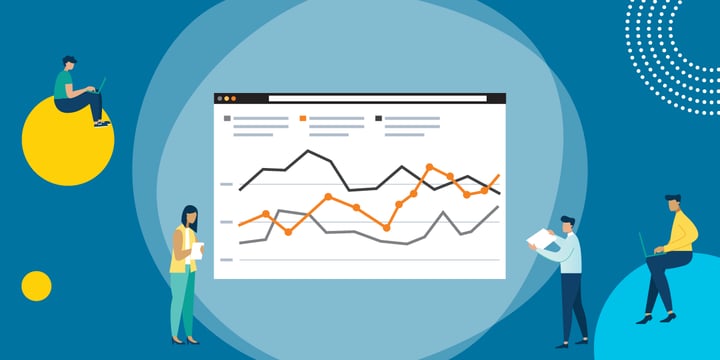There are lots of ways to take digital programs to the next level, most of which revolve around investments of funds and staffing capacity. Equally important is making ongoing performance and qualitative improvements that maximize your engagement with constituents and stakeholders. Improvements like increasing your email open rates, finding the message that resonates best with your audiences, raising more money from your online appeals with smarter strategies, or getting more people to take advocacy actions.
The key to making these qualitative improvements is through testing. You can try making educated guesses or going with your gut, but testing is the best and most reliable way to improve a digital program. Constant changes in digital trends related to devices, platforms, and habits require a digital program to keep improving and innovating through testing.

If You Aren't Testing, You Aren't Learning
Testing is the process of making incremental changes to your digital engagement with the goal of improving your performance outcomes. In digital programs, testing can impact engagement through your email messaging, your website, your fundraising pages, your advocacy action pages, even your social media messaging practices.
Testing is about learning how to do things better, which implies that you've either been doing things wrong or that your target audience behavior is changing and you need to figure out how. Digital campaigning is a fluid process that requires constant adjustments and calibrations to succeed.
Use testing to tackle your biggest digital engagement opportunities, like raising money during your biggest annual fundraising campaign, signing up volunteers, gathering more online petition signatures, or maximizing your next Giving Tuesday campaign.
Review the benchmarks for your nonprofit vertical to see how you compare with others. My favorite digital benchmarks are the M+R's annual Benchmarks Study, which crunches millions of data points from over 150 nonprofits, including fundraising, advocacy, advertising, and website stats. How do your organization's digital metrics compare to other nonprofits'? You may find that you're doing pretty good in some areas but have room for improvement in others.
Master the Fundamentals of Testing
While much of testing deals with improving your digital engagement, it's also about math and statistics. Nonprofits will need to master the fundamentals of A/B testing (also known as split testing) and multivariate testing. A/B testing is the simpler of the two types of testing and can be used to test two variations of the same email message or two versions of a web page to find out which one delivers the best results. The more complex multivariate testing allows you to test many more variations at once, which can save you time in the long run. However, it requires a larger sample size to deliver statistically significant results. I recommend two how-to articles, by NextAfter and Convince & Convert, to prepare you for a testing project.
I recommend two other excellent and detailed articles on testing for digital engagement. They explain all about randomizing your testing audience, selecting the right sample size, picking your test confidence level, and knowing how to determine the statistical significance of your test results.
- The Test Quest: Optimizing Your Donors' Journey is a great article on how to plan your testing project and how to approach doing the analytics to interpret your results.
- 5 Testing Mistakes Everyone Makes Once (and How to Not Make Them Again) is another great article that dissects many aspects of testing and will be invaluable as you embark on your testing journey.
For most nonprofits, conducting an A/B test or a multivariate test to improve the performance of your email messages or email newsletters may be easily accomplished by turning to your email service provider, many of which offer easy-to-use, built-in tools. Popular services such as Constant Contact, Mailchimp, or Salesforce Pardot. Each offers A/B testing tools that will simplify your testing. More fully featured CRMs and digital platforms such as EveryAction, Engaging Networks, and Blackbaud Luminate CRM all offer built-in testing tools.
If you're testing website landing pages, a broad range of online vendors are at your disposal with a range of pricing. They include HubSpot, Google Optimize, Optimizely, VWO Testing, Adobe Target, and Unbounce.
Use Testing to Improve Your Annual Fund Campaign
Annual fund campaigns are often the leading fundraising technique for nonprofits. They can include postal mail, email appeals, in-person events, telephone outreach, and crowdfunding efforts. Annual fund campaigns are perfect laboratories for testing because they recur yearly and results can be compared year over year.
Here are three things you can test to improve your annual fund campaign performance:
- Test different people to sign your appeals. While it might be common to have your executive director sign your appeals, try testing someone else like a popular volunteer or a local celebrity. Use their name in the Email From line, signing the message, and also try adding their photo on the fundraising landing page.
- Test the use of a donor match offer to add a new approach to your annual fund appeal. If the match is being offered by a donor, your board, or a business partner, be sure to call out their role.
- Test the use of a fundraising video to add a new messaging approach.
Use Testing to Increase Email Subscriptions on Your Website
Your website is a key place to encourage email subscription, especially on your home page and the pages that get the most traffic. The M+R's 2018 Benchmarks Study reported that the average email sign-up rate on nonprofit sites is 1.0 percent, with some variability based on organization size and vertical. How does your organization compare with this benchmark? Is there room for improvement?
Here are three things you can test to increase the number of email subscriptions on your website:
- Test the position of the sign-up widget on your homepage so that it's visible above the fold when the page loads. This visual placement is often the number one factor in impacting the email subscription rate.
- Test the call-to-action language that is being used to encourage your website visitors to subscribe to email. Consider moving away from neutral language such as "subscribe to our email newsletter" or "get email updates." Test language that is more action-oriented, such as "Take action and join our online community of 2.2 million supporters," or "Join the movement to protect our ocean," or "I want to join millions of people who are starting to stand up for animals."
- Test the use of a petition. This idea only applies to advocacy-based nonprofits, but it is a tried and true method to grow your email list.
Use Testing to Increase Gifts on Your Main Website Donation Page
On average, only about 20 percent of your donors will complete their gift on a nonprofit donation page, according to the M+R Benchmarks Study. This is an important area for improvement, and testing can significantly move the needle with your online revenue. Sometimes, all it takes to increase your campaign's overall revenue is encouraging more people who have already navigated to your donation page to finish filling out the form.
Here are two things you can test to increase gifts:
- Test the use of a more compelling page headline. Your donors have seen (and filled out) lots of donation pages, so the headline has to really stand out, since it's the first thing they'll see aside from the photo. The best headlines are succinct and to the point but also tap into the reason your donors are motivated to give in the first place. Here are some examples we like: "Donate to save an animal's life today"; "Join us and protect what you love"; "Donate for consumer safety and unbiased, reliable product reviews."
- Test a different image on your donation page. Often images are more powerful than words when it comes to communicating how a donor's gift can help others. Feature an image that reinforces your core message and mission or is connected to the campaign theme.
Further Resources
- The Complete Guide to Using Testing to Increase Digital Engagement
- Top Ten Fundraising Optimizations You Can Try Today
- Landing Page Testing: A Guide To Bring You to Speed
- TechSoup's Website Services
- TechSoup Courses' Google Ad Grants Seminar Series
- An Introduction to Using A/B Testing for Fundraising
- Webinar: How to Make Your Campaigns More Viral







